
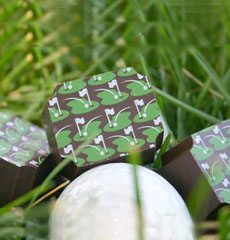
Reward yourself for a good day on the fairway with these golf chocolates from Chocolat Céleste.

|
 |

July 2007 Gourmet News & Views
Trends, Products & Items Of Note In The World Of Specialty Foods
- Click here for the main news page and archives.
- You can receive the news via RSS by clicking on the RSS box above.
- You also can receive a weekly e-mail with links to this page by subscribing to the News Feed.
7.30.07
News
“Safe” Peanut May Be On The Horizon. Scientists at North Carolina Agricultural and Technical State University say they’ve found a way to deactivate peanut allergens 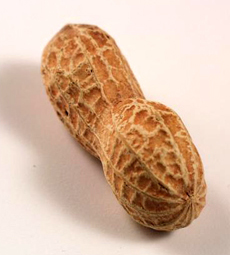 in the lab. They’ve taken the strategy of removing the allergen through processing the peanut after it is harvested rather than through trying to develop a breed of allergen-free peanuts, which is the focus of researchers at the University of Florida. However, while lab tests have been successful, human trials have not yet begun. Even if human trials are successful, it would likely be several years before a “safe peanut” is available to consumers. For many people, it can’t come soon enough: While scientists do not understand the reason why the number of American children with peanut allergies has doubled to more than 600,000 over the past five years; 150 to 200 fatalities were attributed to the allergies last year. About 12 million Americans suffer from a food allergy, according to the American Academy of Allergy, Asthma and Immunology. Eight foods, including milk, peanuts, wheat and shellfish, account for 90% of all reactions. Photo by M. Connors | MorgueFile. in the lab. They’ve taken the strategy of removing the allergen through processing the peanut after it is harvested rather than through trying to develop a breed of allergen-free peanuts, which is the focus of researchers at the University of Florida. However, while lab tests have been successful, human trials have not yet begun. Even if human trials are successful, it would likely be several years before a “safe peanut” is available to consumers. For many people, it can’t come soon enough: While scientists do not understand the reason why the number of American children with peanut allergies has doubled to more than 600,000 over the past five years; 150 to 200 fatalities were attributed to the allergies last year. About 12 million Americans suffer from a food allergy, according to the American Academy of Allergy, Asthma and Immunology. Eight foods, including milk, peanuts, wheat and shellfish, account for 90% of all reactions. Photo by M. Connors | MorgueFile.
Bee Disaster Looming. For reasons that are not understood, there has been a massive die-off of bee colonies in 22 states, puzzling agriculture officials. In the current situation, called colony collapse disorder, the colony’s adult bee population abruptly dies, leaving only the queen and a few attendants alive. Typically, there is no sign of  mite or beetle damage. Some experts think that toxic exposure or nutritional deficits might be undermining the bees’ immune systems. Don’t think “honey shortage”: The issue is much bigger. Nationwide, honeybees pollinate more than 130 crops. According to Agriculture Undersecretary Gale Buchanan, there were enough honeybees to provide pollination for U.S. agriculture this year, but beekeepers could face a serious problem next year and beyond, and entire industries could be jeopardized. Take just one example, California’s nearly $3 billion-a-year almond industry, where 1.3 million of the nation’s 2.4 million commercial bee colonies are hired to pollinate the almond orchards. The bee industry is facing difficulty meeting the demand for almond orchard pollination because of bee shortages in California. Fewer almonds not only mean less income for farmers, but the trickle-down effect impacts manufacturers who produce packaged nuts, almond candies, syrups and other almond-based products—and significantly drive up prices for consumers. Legislators are seeking funding to study the problem; but for now, it is a reverse horror movie, with people waiting to see if the bees will survive. mite or beetle damage. Some experts think that toxic exposure or nutritional deficits might be undermining the bees’ immune systems. Don’t think “honey shortage”: The issue is much bigger. Nationwide, honeybees pollinate more than 130 crops. According to Agriculture Undersecretary Gale Buchanan, there were enough honeybees to provide pollination for U.S. agriculture this year, but beekeepers could face a serious problem next year and beyond, and entire industries could be jeopardized. Take just one example, California’s nearly $3 billion-a-year almond industry, where 1.3 million of the nation’s 2.4 million commercial bee colonies are hired to pollinate the almond orchards. The bee industry is facing difficulty meeting the demand for almond orchard pollination because of bee shortages in California. Fewer almonds not only mean less income for farmers, but the trickle-down effect impacts manufacturers who produce packaged nuts, almond candies, syrups and other almond-based products—and significantly drive up prices for consumers. Legislators are seeking funding to study the problem; but for now, it is a reverse horror movie, with people waiting to see if the bees will survive.
Bottled Water Comes Clean. According to Beverage Digest, U.S. consumers spent about $15 billion on bottled water last year, more than half of which was purified municipal water. The controversy has been mounting abut the recycling cost for plastic water bottles that don’t contain “spring water” or “mineral water,” just purified tap water that people have been led to think—by clever marketing—is the real deal. Basically, it’s not much better than a household with a good filtering system could pour from the tap into their own reusable bottles. According to Corporate 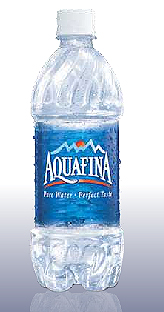 Accountability International, a U.S. watchdog group, Pepsico, marketer of Aquafina, the top-selling brand of bottle water, will include the words “Public Water Source” on Aquafina labels and will spell out that the product is made with tap water. (The front of the label declares, “Pure Water, Perfect Taste.”) This is a huge concession to the growing environmental and political opposition to the bottled water industry. Environmentalists charge that the bottled water industry adds plastic to landfills, uses excessive energy by producing and shipping bottles across the world and undermines confidence in the safety and cleanliness of public water supplies. While we agree that, in a large number of cases, households can help the environment by carrying bottles of water filled from their own taps, and bringing those bottles home to refill, we strongly support the enjoyment of fine mineral waters. Just as people appreciate the differences among wines, others appreciate the difference between club soda and San Pellegrino, which has very high levels of bicarbonates, calcium, chlorides and magnesium that create a very distinctive flavor; or Vichy Catalan, whose mineral levels, many times that of San Pellegrino, were curative waters for the Roman legions and for peoples dating to prehistory. In terms of still water, Coca-Cola’s Dasani and Pepsi’s Aquafina are both made from water that comes from municipal reservoirs, as opposed to Danone’s Evian or Nestle’s Poland Spring, called “spring waters,” bottled at sources (springs) that the companies say have “notably clean water.” Paradoxically, the U.S. municipal water supply is heavily supervised and tested for impurities, while waters from private springs do not fall under such regulation and can, in fact, contain higher levels of contaminants. As a result of the “outing” of bottled municipal water, some fine restaurants nationwide—from the Bay Area to New York City—have stopped selling bottled water. San Francisco’s mayor banned city employees from using city funds to buy bottled water when tap water is available. Ann Arbor, Michigan passed a resolution banning commercially-bottled water at city events and Salt Lake City, Utah has told municipal department heads to cease the purchase of bottled water (a good move, since their tap water was judged best in the nation in a Today Show blind tasting two weeks ago). Read our Water Glossary for an explanation of the terms used in describing the different types of waters. Accountability International, a U.S. watchdog group, Pepsico, marketer of Aquafina, the top-selling brand of bottle water, will include the words “Public Water Source” on Aquafina labels and will spell out that the product is made with tap water. (The front of the label declares, “Pure Water, Perfect Taste.”) This is a huge concession to the growing environmental and political opposition to the bottled water industry. Environmentalists charge that the bottled water industry adds plastic to landfills, uses excessive energy by producing and shipping bottles across the world and undermines confidence in the safety and cleanliness of public water supplies. While we agree that, in a large number of cases, households can help the environment by carrying bottles of water filled from their own taps, and bringing those bottles home to refill, we strongly support the enjoyment of fine mineral waters. Just as people appreciate the differences among wines, others appreciate the difference between club soda and San Pellegrino, which has very high levels of bicarbonates, calcium, chlorides and magnesium that create a very distinctive flavor; or Vichy Catalan, whose mineral levels, many times that of San Pellegrino, were curative waters for the Roman legions and for peoples dating to prehistory. In terms of still water, Coca-Cola’s Dasani and Pepsi’s Aquafina are both made from water that comes from municipal reservoirs, as opposed to Danone’s Evian or Nestle’s Poland Spring, called “spring waters,” bottled at sources (springs) that the companies say have “notably clean water.” Paradoxically, the U.S. municipal water supply is heavily supervised and tested for impurities, while waters from private springs do not fall under such regulation and can, in fact, contain higher levels of contaminants. As a result of the “outing” of bottled municipal water, some fine restaurants nationwide—from the Bay Area to New York City—have stopped selling bottled water. San Francisco’s mayor banned city employees from using city funds to buy bottled water when tap water is available. Ann Arbor, Michigan passed a resolution banning commercially-bottled water at city events and Salt Lake City, Utah has told municipal department heads to cease the purchase of bottled water (a good move, since their tap water was judged best in the nation in a Today Show blind tasting two weeks ago). Read our Water Glossary for an explanation of the terms used in describing the different types of waters.
Food Gift Giving Increases. Although the total market for consumer gift giving 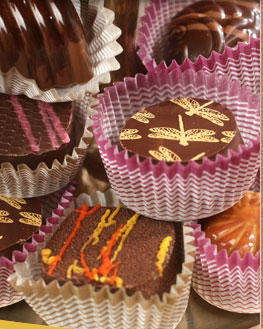 decreased 8% from 2004 to 2006 (due to stagnant population growth of people younger than 14, as well as frustrations over what to purchase), the food gift market grew a whopping 47%, reports market research firm Packaged Facts. The market is expected to grow another 45% by 2010—good news for specialty food producers. According to the survey of more than 25,000 individuals, people like to give gifts of indulgence and gifts that can be shared, both of which apply to food gifts. Not surprisingly, boxed chocolates, the most traditional food gift, are at the top of the list. Feel like jumping on the bandwagon and buying someone a specialty food gift? Check out our Gift Finder. Can’t think of anyone to give a gift to? How about Numero Uno: 25% of respondents bought food gifts for themselves. Chocolates from BTMcElrath.com. decreased 8% from 2004 to 2006 (due to stagnant population growth of people younger than 14, as well as frustrations over what to purchase), the food gift market grew a whopping 47%, reports market research firm Packaged Facts. The market is expected to grow another 45% by 2010—good news for specialty food producers. According to the survey of more than 25,000 individuals, people like to give gifts of indulgence and gifts that can be shared, both of which apply to food gifts. Not surprisingly, boxed chocolates, the most traditional food gift, are at the top of the list. Feel like jumping on the bandwagon and buying someone a specialty food gift? Check out our Gift Finder. Can’t think of anyone to give a gift to? How about Numero Uno: 25% of respondents bought food gifts for themselves. Chocolates from BTMcElrath.com.
Product Watch
No More Excuses: Eat Your Vegetables! Ziploc Brand Zip ‘n Steam Microwave Steam Cooking Bags allow consumers to steam cook healthy meals in minutes in the 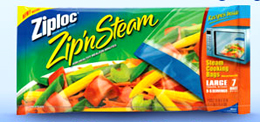 microwave. They’re available now at mass-retailers and grocery stores nationwide, in the same aisle where Ziploc Brand bags and containers are found. The suggested retail price is $2.79 for 10 medium bags (two to three servings per bag) or seven large bags (three to five servings per bag). It’s easy and fun to make steamed vegetables, so even the kids will enjoy making them for meals and snacks. For a low-calorie sauce, mix nonfat yogurt with Dijon mustard. Start with a 5:1 proportion, and add more mustard to taste. microwave. They’re available now at mass-retailers and grocery stores nationwide, in the same aisle where Ziploc Brand bags and containers are found. The suggested retail price is $2.79 for 10 medium bags (two to three servings per bag) or seven large bags (three to five servings per bag). It’s easy and fun to make steamed vegetables, so even the kids will enjoy making them for meals and snacks. For a low-calorie sauce, mix nonfat yogurt with Dijon mustard. Start with a 5:1 proportion, and add more mustard to taste.
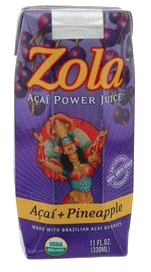 Açaí “Super Juice.” Açaí is popping up everywhere these days (see our recent review of Belizza Açaí Sorbets for a mountain of information about the antioxidant-rich “superfruit”). If you’re looking for a portable juice drink, Zola Açaí Juice is available in 11-ounce Tetra boxes, soft, non-breakable packaging that don’t require refrigeration and can be drunk from the box, through a straw (BYO) or poured into a glass. The tasty juices are made of 100% Açaí pulp and include omega-6 and omega-9 fatty acids, eight of the nine essential amino acids, calcium and iron. Most people will prefer the Acaí + Blueberry and Acaí + Pineapple to the Original, but all three juices are top quality. They’re available in in health food stores, specialty food stores and online at WorldPantry.com. Açaí “Super Juice.” Açaí is popping up everywhere these days (see our recent review of Belizza Açaí Sorbets for a mountain of information about the antioxidant-rich “superfruit”). If you’re looking for a portable juice drink, Zola Açaí Juice is available in 11-ounce Tetra boxes, soft, non-breakable packaging that don’t require refrigeration and can be drunk from the box, through a straw (BYO) or poured into a glass. The tasty juices are made of 100% Açaí pulp and include omega-6 and omega-9 fatty acids, eight of the nine essential amino acids, calcium and iron. Most people will prefer the Acaí + Blueberry and Acaí + Pineapple to the Original, but all three juices are top quality. They’re available in in health food stores, specialty food stores and online at WorldPantry.com.
Trends
All The Coffee In China. While Americans are drinking more tea, the Chinese are drinking more coffee—and given their limited production capabilities, are predicted to  turn into a big coffee importer. The Wall Street Journal reported that China’s coffee consumption grew by an annual rate of 18% from 1999 to 2005, while global coffee consumption only grew by 3% a year during that period. While most Chinese are still tea drinkers, the country’s economy is expanding rapidly, the standard of living is improving and Western foods like bread and coffee are increasingly popular among younger people. The 2008 Olympic Games in Beijing and the World Expo 2010 in Shanghai are expected to greatly increase the country’s coffee consumption. International Coffee Organization Executive Director Nestor Osorio said that, in a country of 1.3 billion people, the Chinese coffee market has the potential to gain up to 250 million consumers—not far from the entire population of the United States! Photo courtesy SXC. turn into a big coffee importer. The Wall Street Journal reported that China’s coffee consumption grew by an annual rate of 18% from 1999 to 2005, while global coffee consumption only grew by 3% a year during that period. While most Chinese are still tea drinkers, the country’s economy is expanding rapidly, the standard of living is improving and Western foods like bread and coffee are increasingly popular among younger people. The 2008 Olympic Games in Beijing and the World Expo 2010 in Shanghai are expected to greatly increase the country’s coffee consumption. International Coffee Organization Executive Director Nestor Osorio said that, in a country of 1.3 billion people, the Chinese coffee market has the potential to gain up to 250 million consumers—not far from the entire population of the United States! Photo courtesy SXC.
Go Organics! The U.S. is the largest market for organic foods and beverages in the world, and is projected to reach sales greater than $43 billion by the year 2010, according to Global Industry Analysts, Inc. In addition to health issues (organic foods are free from herbicides, pesticides and other potentially harmful materials), concern for the environment is also driving a segment of consumers towards organic foods (organic-certified foods must also observe environmentally-conscious practices). The organic produce market is the largest segment of the market, projected to reach sales of $33 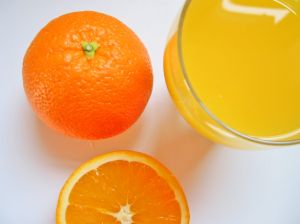 billion by 2010, but there’s a huge demand for organic juices and drinks. The non-dairy organic beverages market is growing faster than the category as a whole, experiencing 18.5% growth during the 10 year analysis period. It’s not just an American phenomenon: Health and wellness are becoming increasingly important to consumers worldwide. The organic foods and beverages market is delivering strong double-digit annual growth globally, projected to exceed $86 billion by 2009 (a compounded annual growth of more than 17% over 10 years). Key players dominating the global organic foods and beverages market include Applegate Farms, Clif Bar & Company, Dakota Beef, Dean Foods, Horizon Organic, Earthbound Farm, Florida Crystals, Hipp, Nature’s Path Foods, Organic Farm Foods, Organic Valley, Rapunzel Naturkost, Spectrum Organic Products, The El Ceibo Cooperative, The Hain Celestial Group and Unilever UK Foods. Photo courtesy SXC. billion by 2010, but there’s a huge demand for organic juices and drinks. The non-dairy organic beverages market is growing faster than the category as a whole, experiencing 18.5% growth during the 10 year analysis period. It’s not just an American phenomenon: Health and wellness are becoming increasingly important to consumers worldwide. The organic foods and beverages market is delivering strong double-digit annual growth globally, projected to exceed $86 billion by 2009 (a compounded annual growth of more than 17% over 10 years). Key players dominating the global organic foods and beverages market include Applegate Farms, Clif Bar & Company, Dakota Beef, Dean Foods, Horizon Organic, Earthbound Farm, Florida Crystals, Hipp, Nature’s Path Foods, Organic Farm Foods, Organic Valley, Rapunzel Naturkost, Spectrum Organic Products, The El Ceibo Cooperative, The Hain Celestial Group and Unilever UK Foods. Photo courtesy SXC.
Go Functional! Functional Foods are growing in tandem, driven by the same forces: health and wellness concerns among aging baby boomers who want longevity. While just a fraction of the organics market—the functional foods market is projected to reach $109 billion by 2010—the trends are definitely spiking up. Functional foods are everyday foods enhanced with supplements that serve a helpful effect on the body beyond normal satiation and nutrition. Examples include calcium-enhanced orange juice, energy drinks market, probiotic yogurt and yogurt drinks. It’s not just cult brands: Coca-Cola, PepsiCo, Cadbury Schweppes, Kellogg's, Unilever, Nestle and Danone (which have purchased the larger functional and organic brands) are world leaders.
7.23.07
News
Road Trip! Celebrating local food in more than 25 towns across America, Sustainable Table, producers of the Eat Well Guide and the Meatrix, is traveling across the country to celebrate local, sustainable food and the folks who produce, distribute, promote and eat it. Kicking off in Hollywood on August 2nd, Sustainable Table’s “Eat Well Guided Tour of America” will travel via bio-fueled bus across the United States, stopping in more than 25 towns on its way to the Farm Aid concert in New York City on September 9th. The tour will visit restaurants that serve local, seasonal and sustainably-produced food, family farms and farmers’ markets in California, Oregon, Washington, Montana, Wyoming, Missouri, Nebraska, Iowa, Minnesota, Illinois, Indiana, Michigan, Ohio, Pennsylvania and New York. Track the tour in the Sustainable Table website and participate as you can.
Country Of Origin Labeling Approved. As a follow-up to last week’s story, the House Agriculture Committee voted Thursday night to require country of origin labels on meats, beginning in 2008. Meats will not be given a USA label unless the animals were born, raised and slaughtered in the United States. The law will also govern fruits, vegetables and peanuts. Processed foods are exempt from the labeling requirements. The Agriculture Department never enacted a 2002 law requiring the labels because then-majority Republicans repeatedly delayed it, most recently to 2008. The labeling program was not delayed for seafood. The former chairman of the Senate Appropriations Committee, Republican Senator Ted Stevens of Alaska, put it in place to promote his state’s lucrative fishing industry. The meat law’s leading opponents have been retailers and large meat packing companies, many of whom mix U.S. and Mexican beef, who have said that the tracking and paperwork needed to comply with the law is too burdensome and would lead to higher prices. Legislative representatives from states that raise cattle have supported the bill, because labeling would help smaller, independent ranchers who face competition from Canadian beef. Last week, compromises softened penalties and record-keeping requirements. On a related note, China is working to clean up its drug and food industries, which are under international scrutiny; substandard Chinese goods have been rejected around the world as dangerous.
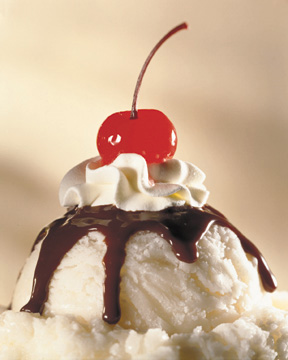 Still Screaming For Ice Cream. Full-fat ice cream remains worth the guilt, says 67% of respondents from a recent survey by Harris Interactive. Moreover, 73% of men and 66% of women would eat full-fat ice cream over other full-fat snacks (such as cookies, chips and candy), perhaps indicating that ice cream is one full-fat pleasure that is too legit to quit. Still, blind taste tests suggest that people typically cannot tell the different between low-fat and full-fat ice cream. Fat content notwithstanding, America embraces ice cream: The International Dairy Foods Association reports that nearly 90% of American households purchase it. Read reviews of our favorite ice cream (advance warning—they’re full fat!). Photo courtesy of Cherry Marketing Institute. Still Screaming For Ice Cream. Full-fat ice cream remains worth the guilt, says 67% of respondents from a recent survey by Harris Interactive. Moreover, 73% of men and 66% of women would eat full-fat ice cream over other full-fat snacks (such as cookies, chips and candy), perhaps indicating that ice cream is one full-fat pleasure that is too legit to quit. Still, blind taste tests suggest that people typically cannot tell the different between low-fat and full-fat ice cream. Fat content notwithstanding, America embraces ice cream: The International Dairy Foods Association reports that nearly 90% of American households purchase it. Read reviews of our favorite ice cream (advance warning—they’re full fat!). Photo courtesy of Cherry Marketing Institute.
Water Winners. With the mounting controversy about recycling costs, landfill waste and highway litter caused by plastic water bottles—Americans spend $30 billion a year on bottled water, and according to San Francisco Mayor Gavin Newsom, 47 million gallons of oil are consumed annually to produce the plastic bottles it comes in—The Today Show held a taste-off to see how tasty America’s municipal water supply is. For the cost of one 16-ounce bottle of water, one can have 1,000 gallons of tap water. Water from 12 cities  nationwide was flown into New York City (NYC’s highly-regarded water was not included in the test). The waters were blind-tested by two experts with highly developed palates, winemaker Joe Bastianich and wine writer David Lynch. The winner: Salt Lake City municipal water, which the judges attributed to the runoff from Rocky Mountain snow. It was described as “viscous, thick and rich,” by Lynch, and “bright, with no flaws” by Bastianich. Runners up included Boston and Columbia, South Carolina. If you live in these three cities and you’re buying bottled water, you could be spending your money better elsewhere. Not all municipal water tasted great. Those at the bottom of the list earned comments like “good for washing your car,” “wouldn’t shower with it” and “tastes like the first glass of water run through a new garden hose.” However, the ever-discrete Today Show named only the winning cities, not the other participants. By the way, in blind taste tests conducted all over America, most people prefer their municipal water to bottled water. If you spend money on bottled water, try a blind test yourself and see whether you’re spending for marketing or reality. Photo by Martin Walls | IST. nationwide was flown into New York City (NYC’s highly-regarded water was not included in the test). The waters were blind-tested by two experts with highly developed palates, winemaker Joe Bastianich and wine writer David Lynch. The winner: Salt Lake City municipal water, which the judges attributed to the runoff from Rocky Mountain snow. It was described as “viscous, thick and rich,” by Lynch, and “bright, with no flaws” by Bastianich. Runners up included Boston and Columbia, South Carolina. If you live in these three cities and you’re buying bottled water, you could be spending your money better elsewhere. Not all municipal water tasted great. Those at the bottom of the list earned comments like “good for washing your car,” “wouldn’t shower with it” and “tastes like the first glass of water run through a new garden hose.” However, the ever-discrete Today Show named only the winning cities, not the other participants. By the way, in blind taste tests conducted all over America, most people prefer their municipal water to bottled water. If you spend money on bottled water, try a blind test yourself and see whether you’re spending for marketing or reality. Photo by Martin Walls | IST.
Orange Juice: Even Better For You. While many of us grew up thinking orange juice was a healthy drink, more people have been laying off O.J. due to the high sugar content. But researchers at the University of Buffalo have concluded that the presence of of flavonoids, powerful antioxidants also found in green tea, help fight diseases such as diabetes and heart disease. The flavonoids present in orange juice were found to suppress oxygen free radicals. The study concluded that the health benefits are more important than fears over the sugar content of the juice. This is good news for those who love orange juice, as well as orange juice marketers.
Product Watch
Organic Snack Favorites. If you’re looking for an Oreo alternative, Late July Organic Snacks recently introduced two new sandwich cookie flavors: Dark Chocolate and Vanilla Bean with Green Tea. “Our mission was to take the ordinary sandwich cookie and upgrade it into something I would love and feel good about sharing with my children,” said co-founder Nicole Dawes. Both flavors are available in single-serving sizes, lunch packs and take home boxes. In addition to improving the Oreo, Late July makes organic (pesticide, herbicide and preservative-free, no artificial flavors or colors) varieties of other American favorites, including Ritz-type crackers, saltines, peanut butter and cheddar cheese sandwich crackers. They are available at retailers nationwide, as well as on Amazon.com, Drugstore.com and other e-tailers (visit LateJuly.com for the list).

Contests
Prize For Cranberry Culinarians. Are you crazy for cranberries? Ocean Spray has a $25,000 reward for the “culinary artist who can concoct the ultimate cranberry recipe.” Don’t submit your Thanksgiving cranberry relish, though. The “Ultimate Cranberry Recipe Contest” aims to convince consumers that the cranberry is a versatile fruit for all seasons. Calling it “the little red wonderberry,” the cranberry, which is high in antioxidants, is more than a juice, too. Drag out those recipes and win that cash! Recipes are due by August 23rd, and finalists will be selected in November. Details can be found at OceanSpray.com.
Win Elvis’ Pink Cadillac (Well, A Replica) & Celebrate New Reese’s Banana PB Cups. Reese’s Peanut Butter Cups are all shook up with the launch of Reese’s Peanut Butter & Banana Creme Cups, featuring Elvis Presley. The “Collector Edition” Reese’s Elvis Cups celebrates The King’s love of peanut butter and banana sandwiches. 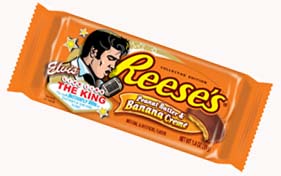 (We’re guessing the collectible is the wrapper, which is made with four different Elvis images...since we can’t believe even ardent Elvis fans can withstand the temptation of the peanut butter cups.) The cups have a thin layer of banana creme on top of the traditional Reese’s creamy peanut butter centers. And, PB cup lovers have the chance to “Live Like The King” with an instant-win promotion. Now through December 31, 2007, more than 10,000 prizes will be given away. Top prizes include a trip for four to Graceland in Memphis and the grand prize, an overhauled, totally redesigned custom Elvis Tribute Car. The 1957 Cadillac is inspired by Elvis’ pink Cadillac and includes all the upgrades and features of a 2007 custom hot rod. The big winner will ride like a rock star with a television, satellite radio, MP3 compatibility, GPS and a mini-refrigerator stocked with Reese’s Elvis Cups. Go cat, go, and visit Reeses.com for details and official rules. (We’re guessing the collectible is the wrapper, which is made with four different Elvis images...since we can’t believe even ardent Elvis fans can withstand the temptation of the peanut butter cups.) The cups have a thin layer of banana creme on top of the traditional Reese’s creamy peanut butter centers. And, PB cup lovers have the chance to “Live Like The King” with an instant-win promotion. Now through December 31, 2007, more than 10,000 prizes will be given away. Top prizes include a trip for four to Graceland in Memphis and the grand prize, an overhauled, totally redesigned custom Elvis Tribute Car. The 1957 Cadillac is inspired by Elvis’ pink Cadillac and includes all the upgrades and features of a 2007 custom hot rod. The big winner will ride like a rock star with a television, satellite radio, MP3 compatibility, GPS and a mini-refrigerator stocked with Reese’s Elvis Cups. Go cat, go, and visit Reeses.com for details and official rules.
Company Watch
This week, we received a press release announcing a joint venture between Starbucks and Hershey’s, where Hershey’s will produce premium chocolate “inspired by Starbucks coffee and café flavors” for sale at Starbucks. At the end of any press release, most companies include their “corporate boilerplate,” a paragraph that gives the reader a snapshot of the company. This typically includes the company’s products, positioning in the marketplace, size of company and other important business facts that distinguish the company from others in the industry. We’ve seen thousands of boilerplates over the years, but never one like Starbucks. Instead of telling, just selling. Here are the two boilerplates, Hershey’s being a traditional example.
About The Hershey Company
The Hershey Company (NYSE: HSY) is the largest North American manufacturer of quality chocolate and sugar confectionery products. With revenues of nearly $5 billion and more than 13,000 employees worldwide, The Hershey Company markets such iconic brands as Hershey’s, Reese’s, Hershey’s Kisses, and Ice Breakers. Hershey is the leader in the fast-growing dark and premium chocolate segment, with such brands as Hershey’s Special Dark, Hershey’s Extra Dark and Cacao Reserve by Hershey’s. In addition, Artisan Confections Company, a wholly owned subsidiary of The Hershey Company, markets such premium chocolate offerings as Scharffen Berger, known for its high-cacao dark chocolate products, Joseph Schmidt, recognized for its fine, handcrafted chocolate gifts, and Dagoba, known for its high-quality natural and organic chocolate bars. Visit us at www.hersheynewsroom.com.
About Starbucks
Starbucks Coffee Company provides an uplifting experience that enriches people’s lives one moment, one human being, one extraordinary cup of coffee at a time. To share in the experience, visit www.starbucks.com.
We don’t want to “share the experience,” Seattle dudes—we want to know something about your company. If this is how your coffee helps the mind focus, switch to herbal tea! (Seriously, we do like your coffee.)
7.16.07
News
Food Allergies On The Rise. The incidence of food allergies has doubled in the past 15 years worldwide, according to an article in The Washington Post, with some of the most severe attacks resulting from peanuts and tree nuts such as cashews. Food allergies now afflict about 4% of adults and 8% of children aged two and younger. Some 12 million Americans suffer from allergies to such widely used foods as eggs, milk, peanuts, soy, tree nuts and wheat. Each year, some 30,000 Americans go to 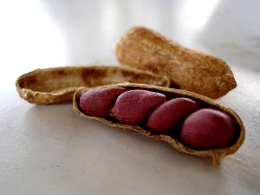 emergency rooms for food allergy attacks, of which 100 to 200 are fatal. Among the theories for the increase are changes in the way food is processed and the age when solid food is introduced to infants. Some experts also contend that our obsession with cleanliness overprotects the immune system, which then reacts too aggressively when confronted with perceived foreign invaders, such as peanuts, instead of just taking them in stride. Allergic reactions can range from itchy hives and a runny nose to a life-threatening anaphylactic attack (the kind produced by bee stings). The severity of the reaction varies according to how many times the food has been eaten, the quantity consumed and the genetic makeup of the allergic person. The good news is that studies show that many children outgrow their allergies; and that about 30% of those who think they have food allergies are mistaken. People with food allergies should read labels carefully before purchasing food, clearly communicate their allergies to restaurant servers, carry emergency treatments like epi-pens and wear medical alert bracelets or other tags to guide emergency personnel, should a reaction occur. emergency rooms for food allergy attacks, of which 100 to 200 are fatal. Among the theories for the increase are changes in the way food is processed and the age when solid food is introduced to infants. Some experts also contend that our obsession with cleanliness overprotects the immune system, which then reacts too aggressively when confronted with perceived foreign invaders, such as peanuts, instead of just taking them in stride. Allergic reactions can range from itchy hives and a runny nose to a life-threatening anaphylactic attack (the kind produced by bee stings). The severity of the reaction varies according to how many times the food has been eaten, the quantity consumed and the genetic makeup of the allergic person. The good news is that studies show that many children outgrow their allergies; and that about 30% of those who think they have food allergies are mistaken. People with food allergies should read labels carefully before purchasing food, clearly communicate their allergies to restaurant servers, carry emergency treatments like epi-pens and wear medical alert bracelets or other tags to guide emergency personnel, should a reaction occur.
Photo of peanuts by Diego Meneghetti | Sxc.
 The Martini Goes Mexican. The Nibble’s founder, Karen Hochman, was runner up in the BarArts “Design Your-Own-Cocktail” Media Challenge, held last week at the New York Marriott Marquis. To celebrate the Marriott’s new bar menu—cocktails containing only natural fruit juices, no artificial mixes—food editors were invited to create their own original cocktails. Hochman’s entry, the Slow Burn Martini, combined vodka with Monin’s Chipotle Pineapple syrup, two dashes of Lemon Bitters, a squeeze of fresh lime and a fresh pineapple garnish. The competition, judged by master mixologist Dale DeGroff and Marriott management, celebrated Marriott’s new bar menu, using only fresh fruit juice—no mixes. Hochman loves her new martini, “It fits in perfectly with our national love of Mexican and Southwestern cuisine. Vodka is by nature a peppery spirit, and the chipotle provides the lingering ‘slow burn’ while the lemon bitters provide sass and the pineapple the offsetting sweetness. It’s my new favorite cocktail.” The Martini Goes Mexican. The Nibble’s founder, Karen Hochman, was runner up in the BarArts “Design Your-Own-Cocktail” Media Challenge, held last week at the New York Marriott Marquis. To celebrate the Marriott’s new bar menu—cocktails containing only natural fruit juices, no artificial mixes—food editors were invited to create their own original cocktails. Hochman’s entry, the Slow Burn Martini, combined vodka with Monin’s Chipotle Pineapple syrup, two dashes of Lemon Bitters, a squeeze of fresh lime and a fresh pineapple garnish. The competition, judged by master mixologist Dale DeGroff and Marriott management, celebrated Marriott’s new bar menu, using only fresh fruit juice—no mixes. Hochman loves her new martini, “It fits in perfectly with our national love of Mexican and Southwestern cuisine. Vodka is by nature a peppery spirit, and the chipotle provides the lingering ‘slow burn’ while the lemon bitters provide sass and the pineapple the offsetting sweetness. It’s my new favorite cocktail.”
Bottle of Red, Bottle of White. Researchers at Italy’s University of Pavia have found evidence that both red and white wines (in this case Valpolicella and Pinot Nero) may help fight cavities. First, the researchers stripped the alcohol out of the wine to prevent the ethanol from interfering with the results. Then, they inserted streptococcal bacteria, which causes cavities and some throat infections, into the wines. Both wines countered the bacteria. However, don’t rush out to buy a case of wine and skip your next dentist appointment—the study was administered in test tubes and still needs further research.
Country-of-Origin Labeling in High Demand. According to the Consumers Union, the nonprofit group that publishes Consumer Reports, 92% of Americans want country-of-origin (COO) labels on food products. Such a high demand for the labeling is no doubt fueled by the recent food contamination scares from a range of products and countries (most recently, domestic peanut butter, spinach, pet food and toothpaste from China). A country-of-origin meat-labeling requirement was enacted by Congress as part of a 2002 law, but the start date as been delayed twice (it is now set for September 30, 2008). Last month, the USDA announced that it would re-open the comment period for COO labeling until August 20th (you can go to USDA.gov and add your comments).
Product Watch
Fancy Foods, Indeed. Last week’s Fancy Food Show was a wild three-day race race through the Javits Center in New York City, trying to find the most exciting new specialty foods among the more than 140,000 on display. What we found—everything 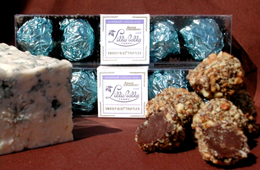 from the best drinkable yogurts from an artisan dairy in Texas, to monkfish liver from France (ankimo lovers—you’ll be thrilled), to soufflés, bread pudding and sticky toffee pudding that are ready to pop into the microwave and emerge as good as the ones you’d get at your favorite restaurant. Two of the more special and exciting treats were from two of our favorite chocolatiers, who continue to push their creativity to new heights each year. This year, Jeff Shepard of Lillie Belle Farms presented a chocolate and blue cheese truffle made with award winning (and Nibble pick) Rogue Creamery Smokey Blue) and a kalamata olive caramel from Nibble Top Pick Chocolat Moderne. from the best drinkable yogurts from an artisan dairy in Texas, to monkfish liver from France (ankimo lovers—you’ll be thrilled), to soufflés, bread pudding and sticky toffee pudding that are ready to pop into the microwave and emerge as good as the ones you’d get at your favorite restaurant. Two of the more special and exciting treats were from two of our favorite chocolatiers, who continue to push their creativity to new heights each year. This year, Jeff Shepard of Lillie Belle Farms presented a chocolate and blue cheese truffle made with award winning (and Nibble pick) Rogue Creamery Smokey Blue) and a kalamata olive caramel from Nibble Top Pick Chocolat Moderne.
Stirrings Solutions. If you don’t trust your own mixologist skills, Stirrings has new 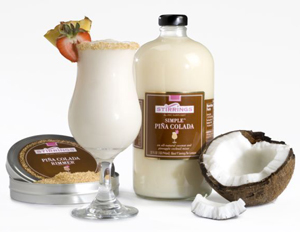 flavors that add punch to your summer entertaining: Passion Fruit Mojito, Grapefruit Margarita, Strawberry Margarita, Caipirinha and Piña Colada are some of the line’s 16 flavors of cocktail mixers. Just add alcohol and stir! Stirrings’ Cocktail Mixers contain all-natural ingredients, like real fruit juice, triple-filtered water and cane sugar. Read our review of Stirrings Cocktail Mixes and Drink Rimmers and other lines of all-natural cocktail mixers. flavors that add punch to your summer entertaining: Passion Fruit Mojito, Grapefruit Margarita, Strawberry Margarita, Caipirinha and Piña Colada are some of the line’s 16 flavors of cocktail mixers. Just add alcohol and stir! Stirrings’ Cocktail Mixers contain all-natural ingredients, like real fruit juice, triple-filtered water and cane sugar. Read our review of Stirrings Cocktail Mixes and Drink Rimmers and other lines of all-natural cocktail mixers.
Instant Piña Colada: Just mix in the rum and add a festive glass rimmer.
Kosher Jelly Beans Get Ready To Span The World. Jelly Belly gourmet jelly beans, available in 50 flavors, are now certified kosher by the Orthodox Union (OU). Jelly Belly had been using a different kosher certification, but believed that the OU certification was necessary since kosher food is growing 15% a year outside the U.S., and the OU symbol is recognized worldwide. In 1976, the first Jelly Belly flavors were introduced: Cream Soda, Grape, Green Apple, Lemon, Licorice, Root Beer, Tangerine and Very Cherry. They are still some of the most popular flavors made, although the line now includes jelly beans in Caramel Corn, Chocolate Pudding, Jalapeño, Peanut Butter, Toasted Marshmallow and Strawberry Cheesecake; plus sugar-free Jelly Bellys, Sports Beans and other confections—all kosher, of course. The OU-certified products will hit retail shelves by the end of the summer.
7.9.07
News
rBST: Not So Bad? rBST, (recombinant bovine somatotropin, commonly known as the bovine growth hormone), is injected in cows to catalyze milk production, and therefore found in most store-bought milk. It has been the subject of endless controversy including links to cancer, infertility, birth defects and a cause of early onset of menstruation. Despite these claims, the drug is FDA-approved and several scientific institutions, including the National Institutes of Health, have issued reports asserting that rBST is not risky to ingest. Henry Miller, the head of the FDA’s Office of 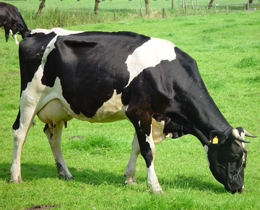 Biotechnology from 1989 to 1993, recently argued in The New York Times that rBST not only isn’t bad for you, but actually helps the environment. He explains that when rBST is injected into cows, the cows’ digestive systems become more efficient at converting feed to milk. Cows can then produce nine gallons of milk per day, instead of the average eight gallons. In other words, you get seven cow’s worth of milk from only six cows. For one million cows, 6.6 billion gallons of water are conserved, three billion pounds less of animal feed are needed and 417 square miles of grazing land are conserved. More than 5.5 million gallons of gasoline and diesel fuel are saved, greenhouse gas emissions are lowered by 30,000 metric tons and manure production is decreased by about 3.6 million tons. Sounds convincing, but consumer and advocacy groups remain wary—as do consumers themselves. In fact, 26% of consumers now purchase some organic milk, at least partially due to the fear of rBST (which is banned in the EU countries and Canada, among other nations). Read more about organic milk. Biotechnology from 1989 to 1993, recently argued in The New York Times that rBST not only isn’t bad for you, but actually helps the environment. He explains that when rBST is injected into cows, the cows’ digestive systems become more efficient at converting feed to milk. Cows can then produce nine gallons of milk per day, instead of the average eight gallons. In other words, you get seven cow’s worth of milk from only six cows. For one million cows, 6.6 billion gallons of water are conserved, three billion pounds less of animal feed are needed and 417 square miles of grazing land are conserved. More than 5.5 million gallons of gasoline and diesel fuel are saved, greenhouse gas emissions are lowered by 30,000 metric tons and manure production is decreased by about 3.6 million tons. Sounds convincing, but consumer and advocacy groups remain wary—as do consumers themselves. In fact, 26% of consumers now purchase some organic milk, at least partially due to the fear of rBST (which is banned in the EU countries and Canada, among other nations). Read more about organic milk.
Photo: Moocho cute, but loaded with controversial growth hormones. Photo courtesy of Wikipedia.
Celebrating National Hot Dog Month. For the 92nd year, Nathan’s Hot Dogs sponsored its annual hot dog eating contest in Coney Island, an oceanside recreational area of New York City. The 50,000 spectators  watched Joey Chestnut overthrow reigning champion Takeru Kobayashi and bring the “mustard yellow” belt back to America. Chestnut also set a new world record by eating 66 hot dogs in 12 minutes. As spectators of the event in past years, we commend Chestnut for his feat of accomplishment, but have no aspirations to become contestants. And with all respect to Nathan’s, a New York institution, we prefer a good organic hot dog, where better meat prevails, fewer spices are needed, and the “beef experience” rules. Read our review. watched Joey Chestnut overthrow reigning champion Takeru Kobayashi and bring the “mustard yellow” belt back to America. Chestnut also set a new world record by eating 66 hot dogs in 12 minutes. As spectators of the event in past years, we commend Chestnut for his feat of accomplishment, but have no aspirations to become contestants. And with all respect to Nathan’s, a New York institution, we prefer a good organic hot dog, where better meat prevails, fewer spices are needed, and the “beef experience” rules. Read our review.
Hot diggity dog. We prefer our hot dogs grilled, and organic. Photo courtesy of Zabars.com.
Chocolate Dreams, Chocolate Misconceptions. Nearly half of Americans—46%—eat chocolate at least a few times per week, according to a recent survey by Barry Callebaut, the world’s largest producer of high-quality cocoa and chocolate (if the name isn’t familiar, it’s because most of their products are ingredients  that get made into finished products by other companies). Despite the ever-increasing sales of dark chocolate, milk chocolate still rules: 81% of responders eat it. The next most popular products are chocolate with nuts, raisins or nougat (70%), dark chocolate (64%), chocolate with a soft praline, fruit or creme filling (54%) and white chocolate (50%). There were connoisseurs among those surveyed: 38% of say they eat single-origin chocolate (chocolate made from cacao beans from a specific region instead of a blend of beans from different origins). That’s more than three times as many as in Europe, where just 10.8 percent were affirmative on single origin cacao. Twenty-four percent eat sugar-free chocolate, 15% report having consumed Fair Trade chocolate and 12% eat functional chocolate (chocolate that has added health or nutrition benefits, e.g. calcium). Now for the misconceptions. Americans feel that chocolate: that get made into finished products by other companies). Despite the ever-increasing sales of dark chocolate, milk chocolate still rules: 81% of responders eat it. The next most popular products are chocolate with nuts, raisins or nougat (70%), dark chocolate (64%), chocolate with a soft praline, fruit or creme filling (54%) and white chocolate (50%). There were connoisseurs among those surveyed: 38% of say they eat single-origin chocolate (chocolate made from cacao beans from a specific region instead of a blend of beans from different origins). That’s more than three times as many as in Europe, where just 10.8 percent were affirmative on single origin cacao. Twenty-four percent eat sugar-free chocolate, 15% report having consumed Fair Trade chocolate and 12% eat functional chocolate (chocolate that has added health or nutrition benefits, e.g. calcium). Now for the misconceptions. Americans feel that chocolate:
- Boosts morale (52%)
- Revitalizes you (46%)
- Is good for the heart and cardiovascular system (31%)
- Contains anti-cancerous ingredients (31%)
- Enhances the memory (16%)
- Enhances sexual performance (15%)
- Helps prevent hair loss (5%)
- The survey also found that 43% would buy chocolate that promises health benefits, and 45% said they would be willing to pay more for “health enhancing” chocolate.
What would your doctor say about all of this? That you should work the calories into your food plan and enjoy chocolate as a pleasurable food, as you’d enjoy chocolate cake or brownies. There are some grains of truth in some of the assertions. There are seratonin reuptake inhibitors in chocolate, and these are the basis of mood elevating drugs. There are antioxidants in chocolate, which in their purest form in lab tests have been shown to fight cancer and Alzheimers. However, the “health benefits” you hear about in the news reports are done in tests using pure, high-quality cocoa powders or high-percentage cacao chocolate, and do not directly translate to the average chocolate bar mixed with lots of sugar and cocoa butter. When you read advertising for products or hear T.V. segments on the “health benefits” of chocolate, think one word: marketing based on a kernel of truth. Photo courtesy of Stock.Xcxhng.
Product Watch
Asian Invasion. Thai Kitchen and Simply Asia have both launched new easy-to-make noodle products–one with rice noodles and one with wheat noodles. Thai Kitchen now offers six flavors of microwaveable rice noodles in “take-out”-style boxes with 100% pure 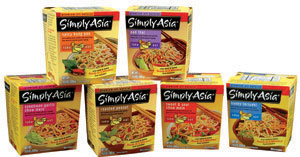 rice noodles that can be brought to work. Each box contains a sauce, a vegetable packet, a topping and a fork. Just add water, pop the meal in the microwave and eat it right out of the box. Choices include Garlic & Roasted Pepper, Ginger & Sweet Chili, Original Pad Thai, Tangy Sweet & Sour, Thai Basil & Chili and Thai Peanut. Simply Asia’s all-in-one stir-fry meals need a frying pan and a burner; then a meal for four will be ready in 15 minutes. Six flavors include Honey Teriyaki, Pad Thai, Roasted Peanut, Spicy Kung Pao, Sweet and Sour Chow Mein and Szechuan Garlic Chow Mein. rice noodles that can be brought to work. Each box contains a sauce, a vegetable packet, a topping and a fork. Just add water, pop the meal in the microwave and eat it right out of the box. Choices include Garlic & Roasted Pepper, Ginger & Sweet Chili, Original Pad Thai, Tangy Sweet & Sour, Thai Basil & Chili and Thai Peanut. Simply Asia’s all-in-one stir-fry meals need a frying pan and a burner; then a meal for four will be ready in 15 minutes. Six flavors include Honey Teriyaki, Pad Thai, Roasted Peanut, Spicy Kung Pao, Sweet and Sour Chow Mein and Szechuan Garlic Chow Mein.
Food Fantasy. With more than exhibitors from 70 countries offering 140,000 food and beverage products, the 53rd Annual Summer Fancy Food Show began on Sunday, July 8th at the Jacob K. Javits Convention Center in New York City. Open only to the trade, it is the largest specialty, natural and organic food event in North America, it runs for three days. THE NIBBLE staff will be running along with it, trying to see as many of the 2,400 exhibitors and tasting as many of the 140,000 products as we can.
Freebies
Is Your Birthday July 13th? It’s the 70th birthday of Krispy Kreme donuts. If you share a birthday (you don’t have to be 70!), Krispy Kreme will give you one free dozen Original Glazed doughnuts. Visit your local Krispy Kreme shop on July 13 and show valid identification to pick up your birthday gift. The company says “at participating locations.” Who could refuse to celebrate your birthday?

7.2.07
News
State Liquor Authority Puts Damper On Beer-sicles. Executive chef Frank Morales of Rustico Restaurant in Alexandria, Virginia developed innovative “beer-sicles,” frozen flavored beers in traditional popsicle and ice cream cone molds. Customers found it a great idea to beat the heat, but state regulators say the innocent-looking pops are illegal. According to state law, beer must be served either in its original container, or served immediately to a customer once it is poured from its original container. Frozen, molded beer is not legal. As every law has its loophole, if Chef Morales creates a “recipe” by adding other ingredients to the product to make “beer sorbet,” then it’s legal. After spending weeks of testing several hundred beer varieties to find flavors that taste good on a stick, Chef Rustico chose three flavors: “Raspbeer-y,” made with a Belgian raspberry beer; “Plum,” made from a Belgian lambic, and “Fudgesicle,” made with a chocolate stout. As he works on it, you can take advantage of his research to make mold beer pops at home. Drag out those ice pop molds—but make sure to keep them away from anyone below drinking age.
Tuna Shortages Create “Nouvelle Sushi” in Japan. While Americans have long enjoyed creative approaches to sushi, the Japanese are purists—no Philadelphia Roll or California Rolls for them. Over the past year, dozens of nations agreed to lower tuna-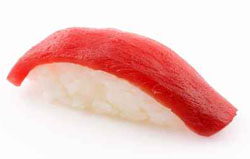 catching limits by 20% in an attempt to stabilize the depleted tuna population, and the decision has had great impact in Japan. In a country where raw tuna is as revered as steak is in the U.S., the smaller catch means that sushi bars are finding it increasingly difficult to buy high-quality tuna in the amounts they once did without forking over substantially more money. Faced with shortages, many Japanese sushi chefs have had to devise creative alternatives to tempt customers. Ingredients that previously never sat atop a pad of rice in Japan, such as duck and avocado, are now being introduced. The New York Times reports that smoked venison and horsemeat are being considered. Both have the red color of tuna; horsemeat is soft and delicate to the palate. American sushi bars, take note! catching limits by 20% in an attempt to stabilize the depleted tuna population, and the decision has had great impact in Japan. In a country where raw tuna is as revered as steak is in the U.S., the smaller catch means that sushi bars are finding it increasingly difficult to buy high-quality tuna in the amounts they once did without forking over substantially more money. Faced with shortages, many Japanese sushi chefs have had to devise creative alternatives to tempt customers. Ingredients that previously never sat atop a pad of rice in Japan, such as duck and avocado, are now being introduced. The New York Times reports that smoked venison and horsemeat are being considered. Both have the red color of tuna; horsemeat is soft and delicate to the palate. American sushi bars, take note!
Product Watch
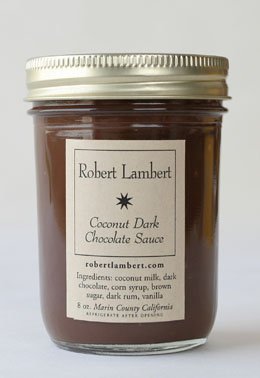 New Robert Lambert Chocolate Sauce. Coconut Dark Chocolate Sauce has joined the line of Robert Lambert chocolate sauces that were a recent Top Pick Of The Week. Made with dark chocolate, coconut milk, dark rum and brown sugar, it delivers light coconut flavor to people who like a touch of the tropics. We enjoyed it on top of some new vanilla gelato from Belizza—a product that’s not yet widely distributed, but will provide new superpremium ice cream punch when it arrives in your neighborhood. The nice thing about Robert Lambert’s Chocolate Sauces is that they multitask as “spoon candy”: Before you heat them, they’re a solid hunk of fudge. Instead of unwrapping a chocolate bar, we’ll often just have a spoonful—hold the ice cream. Read our full review of Robert Lambert Chocolate Sauces. New Robert Lambert Chocolate Sauce. Coconut Dark Chocolate Sauce has joined the line of Robert Lambert chocolate sauces that were a recent Top Pick Of The Week. Made with dark chocolate, coconut milk, dark rum and brown sugar, it delivers light coconut flavor to people who like a touch of the tropics. We enjoyed it on top of some new vanilla gelato from Belizza—a product that’s not yet widely distributed, but will provide new superpremium ice cream punch when it arrives in your neighborhood. The nice thing about Robert Lambert’s Chocolate Sauces is that they multitask as “spoon candy”: Before you heat them, they’re a solid hunk of fudge. Instead of unwrapping a chocolate bar, we’ll often just have a spoonful—hold the ice cream. Read our full review of Robert Lambert Chocolate Sauces.
Smirnoff Mixes Drinks For You. Smirnoff has launched two Smirnoff Cocktails selections—Grand Cosmopolitan and Vodka Mojito. Both drinks use Smirnoff Vodka No. 21. The Grand Cosmopolitan is available in liquor stores nationally and the Vodka Mojito is currently available in the Northeast, and will go national this fall. We’ll be tasting the new cocktails in two weeks at a reception with Tyler Florence, and will report back.
Camelicious. Cow’s milk, sheep’s milk, goat’s milk, water buffalo’s milk—you may  have enjoyed dairy products from all of these milks. Now, is camel’s milk in your future? Camelicious, the product of Emirates Industry for Camel Milk & Products, is taking off in the United Arab Emirates. The government-backed company opened in August 2006, and production is barely keeping up with demand. Camel’s milk contains five times more vitamin C than cow’s milk, is rich in enzymes with anti-bacterial and anti-viral properties, and is effective in treating a variety of ailments including tuberculosis, peptic ulcers, psoriasis and diabetes. The one thing camel’s milk lacks is fat: It has only 2% fat, compared with 4.5% in cow’s milk. As a final selling point, even people with lactose intolerance can drink it, even though it contains about as much lactose as cow’s milk (like sheep’s milk, goat’s milk and water buffalo’s milk, the fat molecules are smaller and more easily digested). Convincing consumers that camel’s milk can be tasty is still an issue, and the product’s name is part of that mission. To appeal to children, it Camelicious comes in date, saffron and strawberry flavors, and the company has plans to branch out into ice cream and luxury chocolates. Unfortunately, regulations in the European Union are a barrier to expansion: No camel milk products can be sold within the EU because of foot-and-mouth disease regulations, despite of the fact that camels are resistant to the disease. But the UAE feels that this obstacle can be overcome through negotiation. In the interim, send some of that Camelicious milk and ice cream to the U.S.A.! have enjoyed dairy products from all of these milks. Now, is camel’s milk in your future? Camelicious, the product of Emirates Industry for Camel Milk & Products, is taking off in the United Arab Emirates. The government-backed company opened in August 2006, and production is barely keeping up with demand. Camel’s milk contains five times more vitamin C than cow’s milk, is rich in enzymes with anti-bacterial and anti-viral properties, and is effective in treating a variety of ailments including tuberculosis, peptic ulcers, psoriasis and diabetes. The one thing camel’s milk lacks is fat: It has only 2% fat, compared with 4.5% in cow’s milk. As a final selling point, even people with lactose intolerance can drink it, even though it contains about as much lactose as cow’s milk (like sheep’s milk, goat’s milk and water buffalo’s milk, the fat molecules are smaller and more easily digested). Convincing consumers that camel’s milk can be tasty is still an issue, and the product’s name is part of that mission. To appeal to children, it Camelicious comes in date, saffron and strawberry flavors, and the company has plans to branch out into ice cream and luxury chocolates. Unfortunately, regulations in the European Union are a barrier to expansion: No camel milk products can be sold within the EU because of foot-and-mouth disease regulations, despite of the fact that camels are resistant to the disease. But the UAE feels that this obstacle can be overcome through negotiation. In the interim, send some of that Camelicious milk and ice cream to the U.S.A.!
Trends
Eat Local, Join The Trend. The local food industry is now worth $5 billion, compared to $4 billion just five years ago. If this trend continues, by 2011, experts project the local food industry to be worth $7 billion. There are several reasons for this jump in profit, including the recent food safety scares which have prompted more people to want to track where their food is coming from. Additionally, the Slow Food movement and the increasing numbers of locavores (people who only eat food grown or produced from within a certain distance of their home, generally 100 miles) are adding attention to the movement.
Gourmet Travel
Mexican Cooking, Beach-Side. Those who want sun, a luxury resort and a cooking school experience can head for the Ritz-Carlton in Cancun. Bring your cooking apron and maybe your favorite knife (just remember not to bring it as a carry-on). The brand-new $500,000 Culinary Center at the resort offers two-hour cooking classes, in everything fro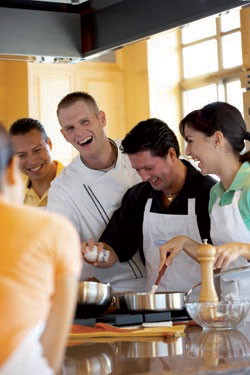 m Thai cuisine to Mexican barbecue. Each cooking station has an induction cook top, an under-counter refrigerator, a convection microwave, an electrical oven, a warming drawer and a pot filler. Riedel glassware and a state-of-the-art Nespresso machine, puts the finishing touch on each culinary session. Classes are six days a week at 11 a.m. and 3 p.m., leaving time for the beach in-between practicing up to be The Next Food Network TV Star. Then, come back for wine and tequila tasting classes at 6:30. m Thai cuisine to Mexican barbecue. Each cooking station has an induction cook top, an under-counter refrigerator, a convection microwave, an electrical oven, a warming drawer and a pot filler. Riedel glassware and a state-of-the-art Nespresso machine, puts the finishing touch on each culinary session. Classes are six days a week at 11 a.m. and 3 p.m., leaving time for the beach in-between practicing up to be The Next Food Network TV Star. Then, come back for wine and tequila tasting classes at 6:30.
News Archives
| 3rd Quarter 2007 |
|
|
|
|
|
| 1st Quarter 2007 |
4th Quarter 2006 |
3rd Quarter 2006 |
|
|
|
| 2nd Quarter 2006 |
1st Quarter 2006 |
4th Quarter 2005 |
|
|
|
| 3rd Quarter 2005 |
2nd Quarter 2005 |
1st Quarter 2005 |
|
|
|
Send your product news to:
Info at TheNibble. com.
Substitute @ for <at> and use TheNibble.com with no space. We use this convention to avoid address-harvesting spam spiders.
Don’t Miss The News:
Subscribe To Our Gourmet News & Views News Feed
Lifestyle Direct Direct, Inc. All rights reserved. Images are the copyright of their respective owners.

|






 in the lab. They’ve taken the strategy of removing the allergen through processing the peanut after it is harvested rather than through trying to develop a breed of allergen-free peanuts, which is the focus of researchers at the University of Florida. However, while lab tests have been successful, human trials have not yet begun. Even if human trials are successful, it would likely be several years before a “safe peanut” is available to consumers. For many people, it can’t come soon enough: While scientists do not understand the reason why the number of American children with peanut allergies has doubled to more than 600,000 over the past five years; 150 to 200 fatalities were attributed to the allergies last year. About 12 million Americans suffer from a food allergy, according to the American Academy of Allergy, Asthma and Immunology. Eight foods, including milk, peanuts, wheat and shellfish, account for 90% of all reactions.
in the lab. They’ve taken the strategy of removing the allergen through processing the peanut after it is harvested rather than through trying to develop a breed of allergen-free peanuts, which is the focus of researchers at the University of Florida. However, while lab tests have been successful, human trials have not yet begun. Even if human trials are successful, it would likely be several years before a “safe peanut” is available to consumers. For many people, it can’t come soon enough: While scientists do not understand the reason why the number of American children with peanut allergies has doubled to more than 600,000 over the past five years; 150 to 200 fatalities were attributed to the allergies last year. About 12 million Americans suffer from a food allergy, according to the American Academy of Allergy, Asthma and Immunology. Eight foods, including milk, peanuts, wheat and shellfish, account for 90% of all reactions.  mite or beetle damage. Some experts think that toxic exposure or nutritional deficits might be undermining the bees’ immune systems. Don’t think “honey shortage”: The issue is much bigger. Nationwide, honeybees pollinate more than 130 crops. According to Agriculture Undersecretary Gale Buchanan, there were enough honeybees to provide pollination for U.S. agriculture this year, but beekeepers could face a serious problem next year and beyond, and entire industries could be jeopardized. Take just one example, California’s nearly $3 billion-a-year almond industry, where 1.3 million of the nation’s 2.4 million commercial bee colonies are hired to pollinate the almond orchards. The bee industry is facing difficulty meeting the demand for almond orchard pollination because of bee shortages in California. Fewer almonds not only mean less income for farmers, but the trickle-down effect impacts manufacturers who produce packaged nuts, almond candies, syrups and other almond-based products—and significantly drive up prices for consumers. Legislators are seeking funding to study the problem; but for now, it is a reverse horror movie, with people waiting to see if the bees will survive.
mite or beetle damage. Some experts think that toxic exposure or nutritional deficits might be undermining the bees’ immune systems. Don’t think “honey shortage”: The issue is much bigger. Nationwide, honeybees pollinate more than 130 crops. According to Agriculture Undersecretary Gale Buchanan, there were enough honeybees to provide pollination for U.S. agriculture this year, but beekeepers could face a serious problem next year and beyond, and entire industries could be jeopardized. Take just one example, California’s nearly $3 billion-a-year almond industry, where 1.3 million of the nation’s 2.4 million commercial bee colonies are hired to pollinate the almond orchards. The bee industry is facing difficulty meeting the demand for almond orchard pollination because of bee shortages in California. Fewer almonds not only mean less income for farmers, but the trickle-down effect impacts manufacturers who produce packaged nuts, almond candies, syrups and other almond-based products—and significantly drive up prices for consumers. Legislators are seeking funding to study the problem; but for now, it is a reverse horror movie, with people waiting to see if the bees will survive. Accountability International, a U.S. watchdog group, Pepsico, marketer of Aquafina, the top-selling brand of bottle water, will include the words “Public Water Source” on Aquafina labels and will spell out that the product is made with tap water. (The front of the label declares, “Pure Water, Perfect Taste.”) This is a huge concession to the growing environmental and political opposition to the bottled water industry. Environmentalists charge that the bottled water industry adds plastic to landfills, uses excessive energy by producing and shipping bottles across the world and undermines confidence in the safety and cleanliness of public water supplies. While we agree that, in a large number of cases, households can help the environment by carrying bottles of water filled from their own taps, and bringing those bottles home to refill, we strongly support the enjoyment of fine mineral waters. Just as people appreciate the differences among wines, others appreciate the difference between club soda and San Pellegrino, which has very high levels of bicarbonates, calcium, chlorides and magnesium that create a very distinctive flavor; or
Accountability International, a U.S. watchdog group, Pepsico, marketer of Aquafina, the top-selling brand of bottle water, will include the words “Public Water Source” on Aquafina labels and will spell out that the product is made with tap water. (The front of the label declares, “Pure Water, Perfect Taste.”) This is a huge concession to the growing environmental and political opposition to the bottled water industry. Environmentalists charge that the bottled water industry adds plastic to landfills, uses excessive energy by producing and shipping bottles across the world and undermines confidence in the safety and cleanliness of public water supplies. While we agree that, in a large number of cases, households can help the environment by carrying bottles of water filled from their own taps, and bringing those bottles home to refill, we strongly support the enjoyment of fine mineral waters. Just as people appreciate the differences among wines, others appreciate the difference between club soda and San Pellegrino, which has very high levels of bicarbonates, calcium, chlorides and magnesium that create a very distinctive flavor; or  decreased 8% from 2004 to 2006 (due to stagnant population growth of people younger than 14, as well as frustrations over what to purchase), the food gift market grew a whopping 47%, reports market research firm Packaged Facts. The market is expected to grow another 45% by 2010—good news for specialty food producers. According to the survey of more than 25,000 individuals, people like to give gifts of indulgence and gifts that can be shared, both of which apply to food gifts. Not surprisingly, boxed chocolates, the most traditional food gift, are at the top of the list. Feel like jumping on the bandwagon and buying someone a specialty food gift? Check out our
decreased 8% from 2004 to 2006 (due to stagnant population growth of people younger than 14, as well as frustrations over what to purchase), the food gift market grew a whopping 47%, reports market research firm Packaged Facts. The market is expected to grow another 45% by 2010—good news for specialty food producers. According to the survey of more than 25,000 individuals, people like to give gifts of indulgence and gifts that can be shared, both of which apply to food gifts. Not surprisingly, boxed chocolates, the most traditional food gift, are at the top of the list. Feel like jumping on the bandwagon and buying someone a specialty food gift? Check out our  microwave. They’re available now at mass-retailers and grocery stores nationwide, in the same aisle where Ziploc Brand bags and containers are found. The suggested retail price is $2.79 for 10 medium bags (two to three servings per bag) or seven large bags (three to five servings per bag). It’s easy and fun to make steamed vegetables, so even the kids will enjoy making them for meals and snacks. For a low-calorie sauce, mix nonfat yogurt with Dijon mustard. Start with a 5:1 proportion, and add more mustard to taste.
microwave. They’re available now at mass-retailers and grocery stores nationwide, in the same aisle where Ziploc Brand bags and containers are found. The suggested retail price is $2.79 for 10 medium bags (two to three servings per bag) or seven large bags (three to five servings per bag). It’s easy and fun to make steamed vegetables, so even the kids will enjoy making them for meals and snacks. For a low-calorie sauce, mix nonfat yogurt with Dijon mustard. Start with a 5:1 proportion, and add more mustard to taste.  Açaí “Super Juice.”
Açaí “Super Juice.” turn into a big coffee importer. The Wall Street Journal reported that China’s coffee consumption grew by an annual rate of 18% from 1999 to 2005, while global coffee consumption only grew by 3% a year during that period. While most Chinese are still tea drinkers, the country’s economy is expanding rapidly, the standard of living is improving and Western foods like bread and coffee are increasingly popular among younger people. The 2008 Olympic Games in Beijing and the World Expo 2010 in Shanghai are expected to greatly increase the country’s coffee consumption. International Coffee Organization Executive Director Nestor Osorio said that, in a country of 1.3 billion people, the Chinese coffee market has the potential to gain up to 250 million consumers—not far from the entire population of the United States!
turn into a big coffee importer. The Wall Street Journal reported that China’s coffee consumption grew by an annual rate of 18% from 1999 to 2005, while global coffee consumption only grew by 3% a year during that period. While most Chinese are still tea drinkers, the country’s economy is expanding rapidly, the standard of living is improving and Western foods like bread and coffee are increasingly popular among younger people. The 2008 Olympic Games in Beijing and the World Expo 2010 in Shanghai are expected to greatly increase the country’s coffee consumption. International Coffee Organization Executive Director Nestor Osorio said that, in a country of 1.3 billion people, the Chinese coffee market has the potential to gain up to 250 million consumers—not far from the entire population of the United States!  billion by 2010, but there’s a huge demand for organic juices and drinks. The non-dairy organic beverages market is growing faster than the category as a whole, experiencing 18.5% growth during the 10 year analysis period. It’s not just an American phenomenon: Health and wellness are becoming increasingly important to consumers worldwide. The organic foods and beverages market is delivering strong double-digit annual growth globally, projected to exceed $86 billion by 2009 (a compounded annual growth of more than 17% over 10 years). Key players dominating the global organic foods and beverages market include Applegate Farms, Clif Bar & Company, Dakota Beef, Dean Foods, Horizon Organic, Earthbound Farm, Florida Crystals, Hipp, Nature’s Path Foods, Organic Farm Foods, Organic Valley, Rapunzel Naturkost, Spectrum Organic Products, The El Ceibo Cooperative, The Hain Celestial Group and Unilever UK Foods.
billion by 2010, but there’s a huge demand for organic juices and drinks. The non-dairy organic beverages market is growing faster than the category as a whole, experiencing 18.5% growth during the 10 year analysis period. It’s not just an American phenomenon: Health and wellness are becoming increasingly important to consumers worldwide. The organic foods and beverages market is delivering strong double-digit annual growth globally, projected to exceed $86 billion by 2009 (a compounded annual growth of more than 17% over 10 years). Key players dominating the global organic foods and beverages market include Applegate Farms, Clif Bar & Company, Dakota Beef, Dean Foods, Horizon Organic, Earthbound Farm, Florida Crystals, Hipp, Nature’s Path Foods, Organic Farm Foods, Organic Valley, Rapunzel Naturkost, Spectrum Organic Products, The El Ceibo Cooperative, The Hain Celestial Group and Unilever UK Foods.  Still Screaming For Ice Cream.
Still Screaming For Ice Cream.  nationwide was flown into New York City (NYC’s highly-regarded water was not included in the test). The waters were blind-tested by two experts with highly developed palates, winemaker Joe Bastianich and wine writer David Lynch. The winner: Salt Lake City municipal water, which the judges attributed to the runoff from Rocky Mountain snow. It was described as “viscous, thick and rich,” by Lynch, and “bright, with no flaws” by Bastianich. Runners up included Boston and Columbia, South Carolina. If you live in these three cities and you’re buying bottled water, you could be spending your money better elsewhere. Not all municipal water tasted great. Those at the bottom of the list earned comments like “good for washing your car,” “wouldn’t shower with it” and “tastes like the first glass of water run through a new garden hose.” However, the ever-discrete Today Show named only the winning cities, not the other participants. By the way, in blind taste tests conducted all over America, most people prefer their municipal water to bottled water. If you spend money on bottled water, try a blind test yourself and see whether you’re spending for marketing or reality.
nationwide was flown into New York City (NYC’s highly-regarded water was not included in the test). The waters were blind-tested by two experts with highly developed palates, winemaker Joe Bastianich and wine writer David Lynch. The winner: Salt Lake City municipal water, which the judges attributed to the runoff from Rocky Mountain snow. It was described as “viscous, thick and rich,” by Lynch, and “bright, with no flaws” by Bastianich. Runners up included Boston and Columbia, South Carolina. If you live in these three cities and you’re buying bottled water, you could be spending your money better elsewhere. Not all municipal water tasted great. Those at the bottom of the list earned comments like “good for washing your car,” “wouldn’t shower with it” and “tastes like the first glass of water run through a new garden hose.” However, the ever-discrete Today Show named only the winning cities, not the other participants. By the way, in blind taste tests conducted all over America, most people prefer their municipal water to bottled water. If you spend money on bottled water, try a blind test yourself and see whether you’re spending for marketing or reality. 
 emergency rooms for food allergy attacks, of which 100 to 200 are fatal. Among the theories for the increase are changes in the way food is processed and the age when solid food is introduced to infants. Some experts also contend that our obsession with cleanliness overprotects the immune system, which then reacts too aggressively when confronted with perceived foreign invaders, such as peanuts, instead of just taking them in stride. Allergic reactions can range from itchy hives and a runny nose to a life-threatening anaphylactic attack (the kind produced by bee stings). The severity of the reaction varies according to how many times the food has been eaten, the quantity consumed and the genetic makeup of the allergic person. The good news is that studies show that many children outgrow their allergies; and that about 30% of those who think they have food allergies are mistaken. People with food allergies should read labels carefully before purchasing food, clearly communicate their allergies to restaurant servers, carry emergency treatments like epi-pens and wear medical alert bracelets or other tags to guide emergency personnel, should a reaction occur.
emergency rooms for food allergy attacks, of which 100 to 200 are fatal. Among the theories for the increase are changes in the way food is processed and the age when solid food is introduced to infants. Some experts also contend that our obsession with cleanliness overprotects the immune system, which then reacts too aggressively when confronted with perceived foreign invaders, such as peanuts, instead of just taking them in stride. Allergic reactions can range from itchy hives and a runny nose to a life-threatening anaphylactic attack (the kind produced by bee stings). The severity of the reaction varies according to how many times the food has been eaten, the quantity consumed and the genetic makeup of the allergic person. The good news is that studies show that many children outgrow their allergies; and that about 30% of those who think they have food allergies are mistaken. People with food allergies should read labels carefully before purchasing food, clearly communicate their allergies to restaurant servers, carry emergency treatments like epi-pens and wear medical alert bracelets or other tags to guide emergency personnel, should a reaction occur.
 from the best drinkable yogurts from an artisan dairy in Texas, to monkfish liver from France (ankimo lovers—you’ll be thrilled), to soufflés, bread pudding and sticky toffee pudding that are ready to pop into the microwave and emerge as good as the ones you’d get at your favorite restaurant. Two of the more special and exciting treats were from two of our favorite chocolatiers, who continue to push their creativity to new heights each year. This year, Jeff Shepard of
from the best drinkable yogurts from an artisan dairy in Texas, to monkfish liver from France (ankimo lovers—you’ll be thrilled), to soufflés, bread pudding and sticky toffee pudding that are ready to pop into the microwave and emerge as good as the ones you’d get at your favorite restaurant. Two of the more special and exciting treats were from two of our favorite chocolatiers, who continue to push their creativity to new heights each year. This year, Jeff Shepard of 

 Biotechnology from 1989 to 1993, recently argued in The New York Times that rBST not only isn’t bad for you, but actually helps the environment. He explains that when rBST is injected into cows, the cows’ digestive systems become more efficient at converting feed to milk. Cows can then produce nine gallons of milk per day, instead of the average eight gallons. In other words, you get seven cow’s worth of milk from only six cows. For one million cows, 6.6 billion gallons of water are conserved, three billion pounds less of animal feed are needed and 417 square miles of grazing land are conserved. More than 5.5 million gallons of gasoline and diesel fuel are saved, greenhouse gas emissions are lowered by 30,000 metric tons and manure production is decreased by about 3.6 million tons. Sounds convincing, but consumer and advocacy groups remain wary—as do consumers themselves. In fact, 26% of consumers now purchase some organic milk, at least partially due to the fear of rBST (which is banned in the EU countries and Canada, among other nations). Read more about
Biotechnology from 1989 to 1993, recently argued in The New York Times that rBST not only isn’t bad for you, but actually helps the environment. He explains that when rBST is injected into cows, the cows’ digestive systems become more efficient at converting feed to milk. Cows can then produce nine gallons of milk per day, instead of the average eight gallons. In other words, you get seven cow’s worth of milk from only six cows. For one million cows, 6.6 billion gallons of water are conserved, three billion pounds less of animal feed are needed and 417 square miles of grazing land are conserved. More than 5.5 million gallons of gasoline and diesel fuel are saved, greenhouse gas emissions are lowered by 30,000 metric tons and manure production is decreased by about 3.6 million tons. Sounds convincing, but consumer and advocacy groups remain wary—as do consumers themselves. In fact, 26% of consumers now purchase some organic milk, at least partially due to the fear of rBST (which is banned in the EU countries and Canada, among other nations). Read more about  watched Joey Chestnut overthrow reigning champion Takeru Kobayashi and bring the “mustard yellow” belt back to America. Chestnut also set a new world record by eating 66 hot dogs in 12 minutes. As spectators of the event in past years, we commend Chestnut for his feat of accomplishment, but have no aspirations to become contestants. And with all respect to Nathan’s, a New York institution, we prefer a good organic hot dog, where better meat prevails, fewer spices are needed, and the “beef experience” rules.
watched Joey Chestnut overthrow reigning champion Takeru Kobayashi and bring the “mustard yellow” belt back to America. Chestnut also set a new world record by eating 66 hot dogs in 12 minutes. As spectators of the event in past years, we commend Chestnut for his feat of accomplishment, but have no aspirations to become contestants. And with all respect to Nathan’s, a New York institution, we prefer a good organic hot dog, where better meat prevails, fewer spices are needed, and the “beef experience” rules.  that get made into finished products by other companies). Despite the ever-increasing sales of dark chocolate, milk chocolate still rules: 81% of responders eat it. The next most popular products are chocolate with nuts, raisins or nougat (70%), dark chocolate (64%), chocolate with a soft praline, fruit or creme filling (54%) and white chocolate (50%). There were connoisseurs among those surveyed: 38% of say they eat single-origin chocolate (chocolate made from cacao beans from a specific region instead of a blend of beans from different origins). That’s more than three times as many as in Europe, where just 10.8 percent were affirmative on single origin cacao. Twenty-four percent eat sugar-free chocolate, 15% report having consumed Fair Trade chocolate and 12% eat functional chocolate (chocolate that has added health or nutrition benefits, e.g. calcium). Now for the misconceptions. Americans feel that chocolate:
that get made into finished products by other companies). Despite the ever-increasing sales of dark chocolate, milk chocolate still rules: 81% of responders eat it. The next most popular products are chocolate with nuts, raisins or nougat (70%), dark chocolate (64%), chocolate with a soft praline, fruit or creme filling (54%) and white chocolate (50%). There were connoisseurs among those surveyed: 38% of say they eat single-origin chocolate (chocolate made from cacao beans from a specific region instead of a blend of beans from different origins). That’s more than three times as many as in Europe, where just 10.8 percent were affirmative on single origin cacao. Twenty-four percent eat sugar-free chocolate, 15% report having consumed Fair Trade chocolate and 12% eat functional chocolate (chocolate that has added health or nutrition benefits, e.g. calcium). Now for the misconceptions. Americans feel that chocolate:  rice noodles that can be brought to work. Each box contains a sauce, a vegetable packet, a topping and a fork. Just add water, pop the meal in the microwave and eat it right out of the box. Choices include Garlic & Roasted Pepper, Ginger & Sweet Chili, Original Pad Thai, Tangy Sweet & Sour, Thai Basil & Chili and Thai Peanut. Simply Asia’s all-in-one stir-fry meals need a frying pan and a burner; then a meal for four will be ready in 15 minutes. Six flavors include Honey Teriyaki, Pad Thai, Roasted Peanut, Spicy Kung Pao, Sweet and Sour Chow Mein and Szechuan Garlic Chow Mein.
rice noodles that can be brought to work. Each box contains a sauce, a vegetable packet, a topping and a fork. Just add water, pop the meal in the microwave and eat it right out of the box. Choices include Garlic & Roasted Pepper, Ginger & Sweet Chili, Original Pad Thai, Tangy Sweet & Sour, Thai Basil & Chili and Thai Peanut. Simply Asia’s all-in-one stir-fry meals need a frying pan and a burner; then a meal for four will be ready in 15 minutes. Six flavors include Honey Teriyaki, Pad Thai, Roasted Peanut, Spicy Kung Pao, Sweet and Sour Chow Mein and Szechuan Garlic Chow Mein.
 catching limits by 20% in an attempt to stabilize the depleted tuna population, and the decision has had great impact in Japan. In a country where raw tuna is as revered as steak is in the U.S., the smaller catch means that sushi bars are finding it increasingly difficult to buy high-quality tuna in the amounts they once did without forking over substantially more money. Faced with shortages, many Japanese sushi chefs have had to devise creative alternatives to tempt customers. Ingredients that previously never sat atop a pad of rice in Japan, such as duck and avocado, are now being introduced. The New York Times reports that smoked venison and horsemeat are being considered. Both have the red color of tuna; horsemeat is soft and delicate to the palate. American sushi bars, take note!
catching limits by 20% in an attempt to stabilize the depleted tuna population, and the decision has had great impact in Japan. In a country where raw tuna is as revered as steak is in the U.S., the smaller catch means that sushi bars are finding it increasingly difficult to buy high-quality tuna in the amounts they once did without forking over substantially more money. Faced with shortages, many Japanese sushi chefs have had to devise creative alternatives to tempt customers. Ingredients that previously never sat atop a pad of rice in Japan, such as duck and avocado, are now being introduced. The New York Times reports that smoked venison and horsemeat are being considered. Both have the red color of tuna; horsemeat is soft and delicate to the palate. American sushi bars, take note! New Robert Lambert Chocolate Sauce.
New Robert Lambert Chocolate Sauce.  have enjoyed dairy products from all of these milks. Now, is camel’s milk in your future? Camelicious, the product of Emirates Industry for Camel Milk & Products, is taking off in the United Arab Emirates. The government-backed company opened in August 2006, and production is barely keeping up with demand. Camel’s milk contains five times more vitamin C than cow’s milk, is rich in enzymes with anti-bacterial and anti-viral properties, and is effective in treating a variety of ailments including tuberculosis, peptic ulcers, psoriasis and diabetes. The one thing camel’s milk lacks is fat: It has only 2% fat, compared with 4.5% in cow’s milk. As a final selling point, even people with lactose intolerance can drink it, even though it contains about as much lactose as cow’s milk (like sheep’s milk, goat’s milk and water buffalo’s milk, the fat molecules are smaller and more easily digested). Convincing consumers that camel’s milk can be tasty is still an issue, and the product’s name is part of that mission. To appeal to children, it Camelicious comes in date, saffron and strawberry flavors, and the company has plans to branch out into ice cream and luxury chocolates. Unfortunately, regulations in the European Union are a barrier to expansion: No camel milk products can be sold within the EU because of foot-and-mouth disease regulations, despite of the fact that camels are resistant to the disease. But the UAE feels that this obstacle can be overcome through negotiation. In the interim, send some of that Camelicious milk and ice cream to the U.S.A.!
have enjoyed dairy products from all of these milks. Now, is camel’s milk in your future? Camelicious, the product of Emirates Industry for Camel Milk & Products, is taking off in the United Arab Emirates. The government-backed company opened in August 2006, and production is barely keeping up with demand. Camel’s milk contains five times more vitamin C than cow’s milk, is rich in enzymes with anti-bacterial and anti-viral properties, and is effective in treating a variety of ailments including tuberculosis, peptic ulcers, psoriasis and diabetes. The one thing camel’s milk lacks is fat: It has only 2% fat, compared with 4.5% in cow’s milk. As a final selling point, even people with lactose intolerance can drink it, even though it contains about as much lactose as cow’s milk (like sheep’s milk, goat’s milk and water buffalo’s milk, the fat molecules are smaller and more easily digested). Convincing consumers that camel’s milk can be tasty is still an issue, and the product’s name is part of that mission. To appeal to children, it Camelicious comes in date, saffron and strawberry flavors, and the company has plans to branch out into ice cream and luxury chocolates. Unfortunately, regulations in the European Union are a barrier to expansion: No camel milk products can be sold within the EU because of foot-and-mouth disease regulations, despite of the fact that camels are resistant to the disease. But the UAE feels that this obstacle can be overcome through negotiation. In the interim, send some of that Camelicious milk and ice cream to the U.S.A.!  m Thai cuisine to Mexican barbecue. Each cooking station has an induction cook top, an under-counter refrigerator, a convection microwave, an electrical oven, a warming drawer and a pot filler. Riedel glassware and a state-of-the-art Nespresso machine, puts the finishing touch on each culinary session. Classes are six days a week at 11 a.m. and 3 p.m., leaving time for the beach in-between practicing up to be The Next Food Network TV Star. Then, come back for wine and tequila tasting classes at 6:30.
m Thai cuisine to Mexican barbecue. Each cooking station has an induction cook top, an under-counter refrigerator, a convection microwave, an electrical oven, a warming drawer and a pot filler. Riedel glassware and a state-of-the-art Nespresso machine, puts the finishing touch on each culinary session. Classes are six days a week at 11 a.m. and 3 p.m., leaving time for the beach in-between practicing up to be The Next Food Network TV Star. Then, come back for wine and tequila tasting classes at 6:30.